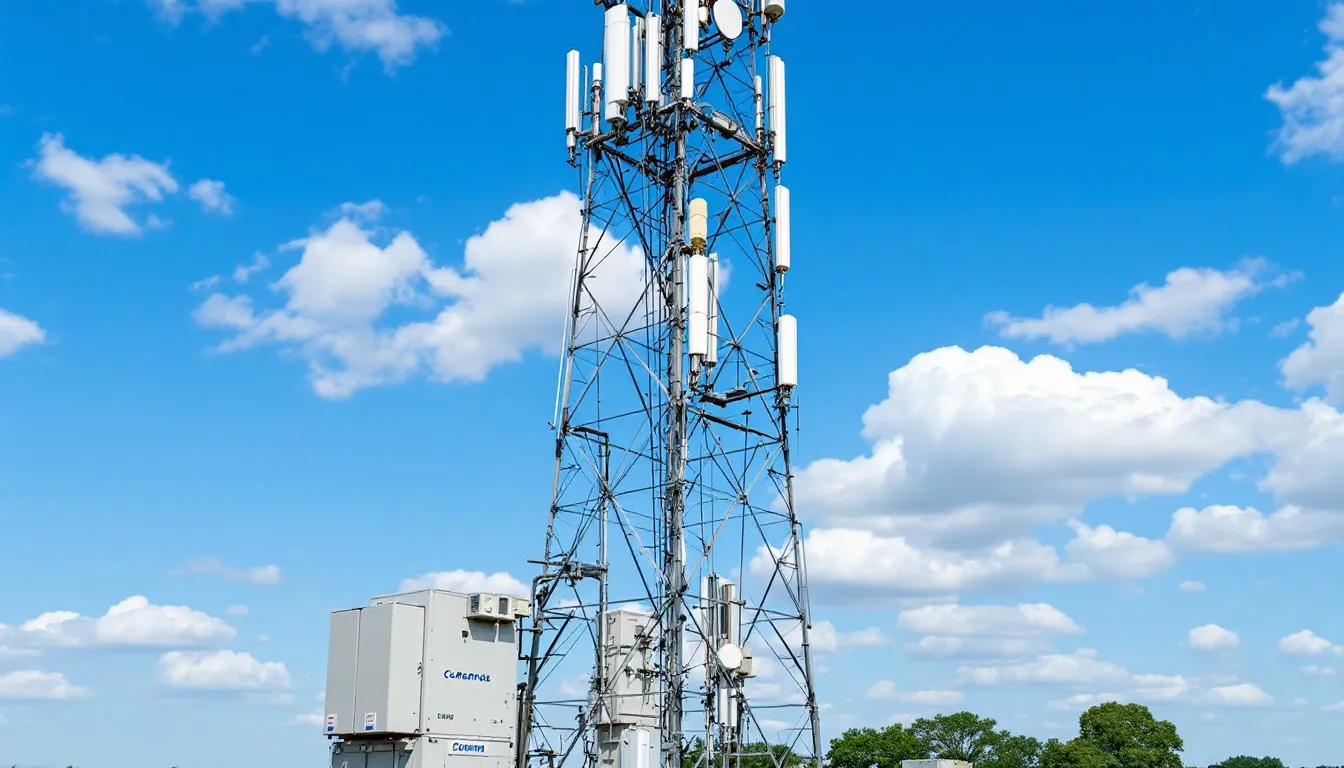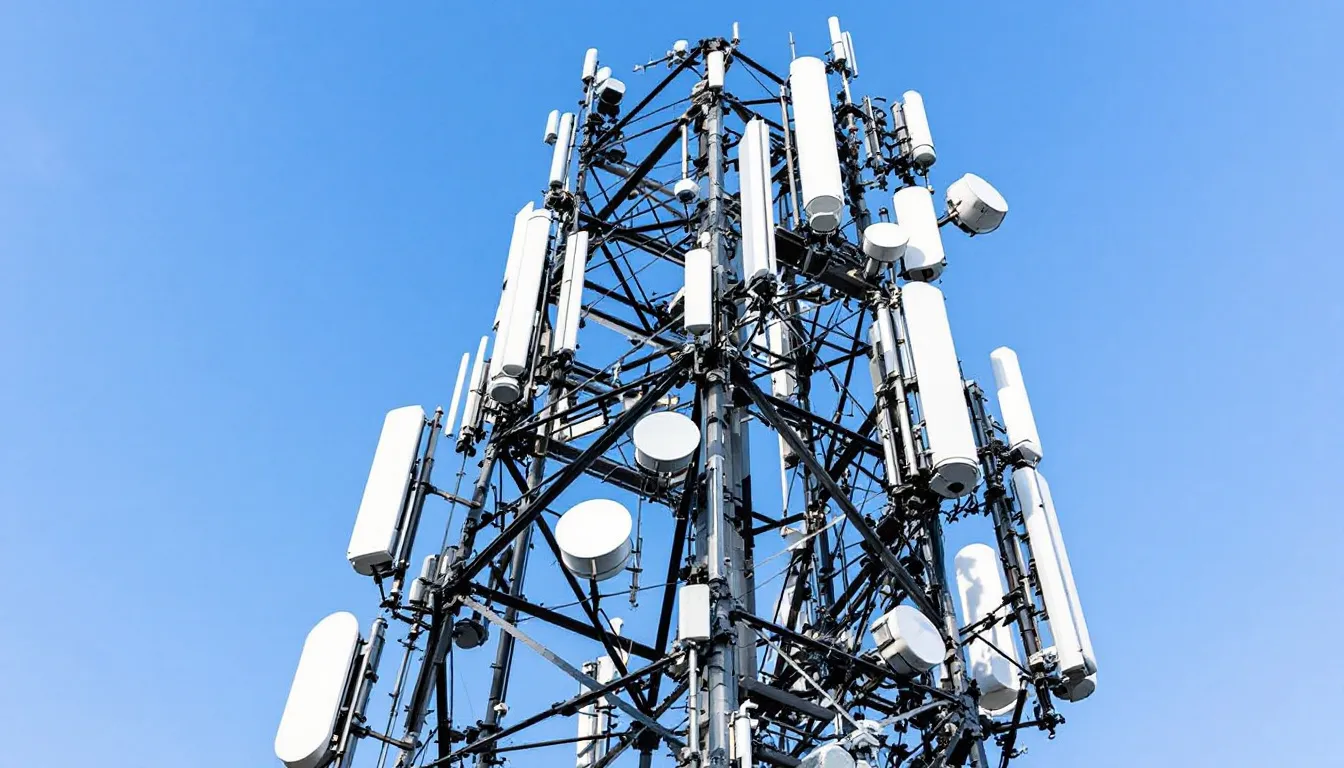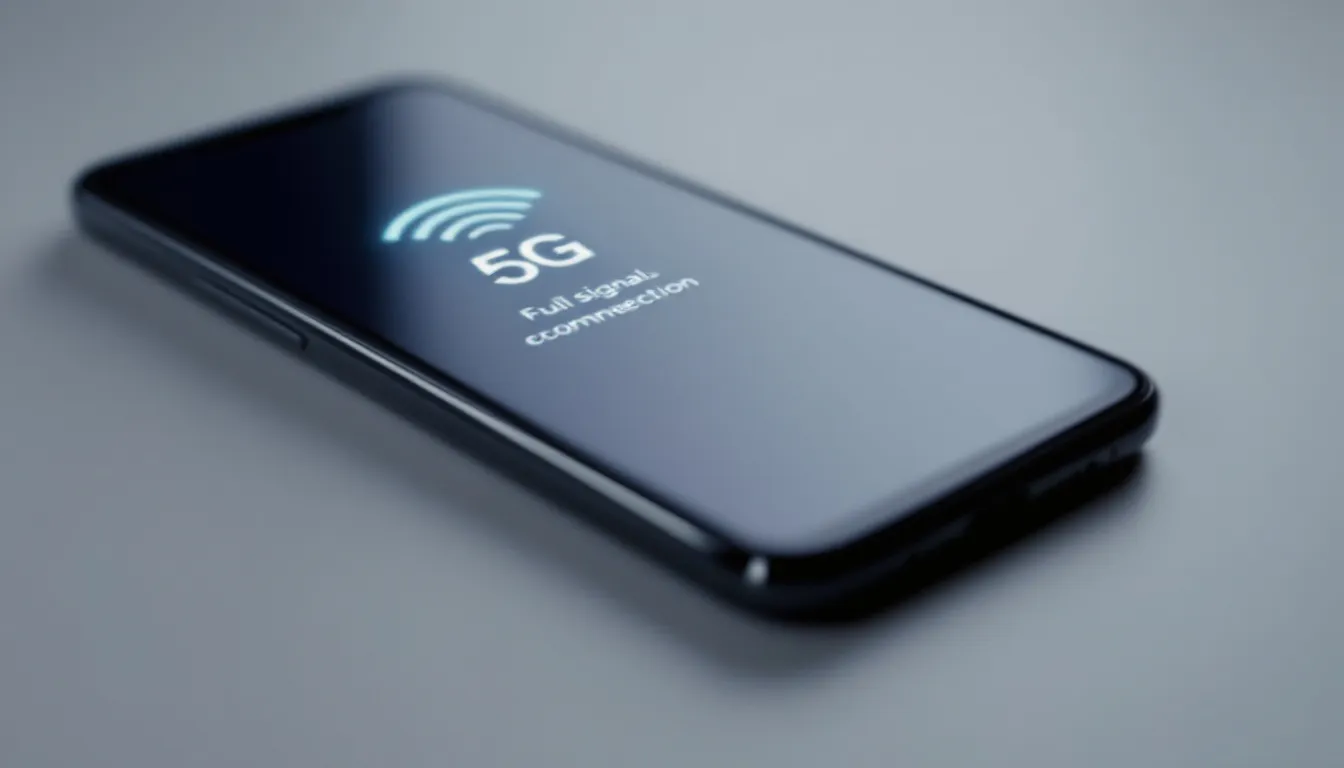When choosing a mobile carrier, many consumers wonder about the infrastructure powering their service. A common question is how coverage between AT&T, Verizon and T Mobile compare, or even whether smaller providers like Spectrum use Verizon towers to provide coverage. However, these are all misconception arising from confusion about tower sharing versus network independence.
The short answer is, however, no.
T Mobile operates its own independent network and does not rely on Verizon towers for primary coverage, not even during major outages. As a major network operator (MNO), T Mobile owns and operates its own cell towers, unlike MVNOs that lease access from larger carriers. Understanding modern cellular networks, tower ownership, and roaming agreements clarifies how T Mobile builds its comprehensive coverage.
This guide explores T Mobile’s independent network, the difference between roaming and tower sharing, and coverage comparisons to explain how T Mobile delivers service across the U.S.
Introduction to T-Mobile
T-Mobile is a major U.S. carrier known for its robust network and reliable coverage. As an MNO, it builds and maintains its own infrastructure, including towers and equipment, rather than relying on others. This independence enables fast speeds and extensive 5G coverage nationwide.
5G Innovation and T Mobile
Focused on innovation, TM has heavily invested in expanding its 5G network, offering plans from unlimited data to budget-friendly options, all supported by its own network. Whether you want a new phone, high-speed data, or reliable service, T-Mobile’s network is a top choice nationwide.
Quick Answer: Does TMobile Use Verizon Towers
T-Mobile does not use Verizon towers for primary coverage. Instead, it owns and operates its nationwide cellular tower infrastructure, forming the foundation for all customer connections. T Mobile built its own 4G LTE and 5G networks independently, ensuring control over service quality and performance.
T Mobile customers rely exclusively on T Mobile’s towers, connecting to company-owned infrastructure nationwide. This approach lets T Mobile optimize its network for specific technologies, spectrum, and customer needs without depending on competitors.
Confusion arises because carriers may lease space on the same physical towers from third-party companies. However, each installs separate radio equipment and maintains independent networks, ensuring separate service even when sharing tower sites.

T-Mobile’s 5G Coverage Map and Network Infrastructure
T Mobile operates as a major network operator with its own cellular towers and equipment spanning the entire United States. The company holds FCC spectrum licenses across multiple frequency bands, enabling it to build towers and provide coverage independently from other major carriers like Verizon and AT&T.
The carrier’s network infrastructure expanded significantly after acquiring Sprint in 2020, adding thousands of additional cell towers and valuable mid-band spectrum to its portfolio. This merger allowed T Mobile to enhance its 5g coverage while maintaining complete network independence from Verizon’s network.
The Benefits of Having Your Own Network
T Mobile manages its own network cores for both 4g lte and 5g technologies, ensuring end-to-end control over data routing, call processing, and feature implementation. This infrastructure includes not only towers but also switching centers, backhaul connections, and network management systems that operate separately from Verizon’s infrastructure.
The company’s investment in its own network reaches billions of dollars annually, demonstrating its commitment to maintaining independent infrastructure rather than relying on Verizon towers or other carrier partnerships for primary coverage. The company’s ongoing focus on future developments and improvements in network technology highlights its dedication to advancing connectivity and meeting industry expectations.
5G Network Roaming vs Tower Sharing
Understanding the distinction between network roaming and tower sharing is crucial when evaluating whether T Mobile use Verizon towers. These two concepts are often confused but represent fundamentally different arrangements between carriers.
Network roaming occurs when T Mobile may use local partner networks in remote areas for limited roaming coverage. These roaming agreements are different from using another carrier’s towers as primary infrastructure and typically apply only in very rural areas where T Mobile has no native coverage. Areas covered by T-Mobile’s own network include most urban and suburban regions, while the most remote or sparsely populated locations are covered by roaming partners.
Boost Mobile Data With T Mobile Best Deals
Most T Mobile plans include limited data allowances when roaming on partner networks, with significantly reduced speeds compared to t mobile’s own network. Roaming typically occurs in very rural areas where building native infrastructure may not be economically viable for all carriers.
Tower sharing, on the other hand, refers to multiple carriers leasing space on the same physical tower structure from independent tower companies. In these arrangements, each carrier installs its own equipment and maintains separate networks, despite sharing the same tower real estate. This practice is common industry-wide but doesn’t involve carriers accessing each other’s networks.
T-Mobile’s Three Network Technologies
T Mobile operates three distinct network technologies independently, providing comprehensive coverage across different use cases and geographic areas. Each network utilizes t mobile’s own infrastructure and spectrum holdings.
t mobile’s network is recognized for its extensive 5G coverage, strong speed performance, and reliable service nationwide, especially following its advancements after the Sprint acquisition.
4G LTE Cell Towers Network Coverage
t mobile’s 4g lte network covers 99% of the U.S. population on its own towers, providing the foundation for nationwide mobile connectivity. The 4g network spans 46.6% of total U.S. land area using T Mobile infrastructure, ensuring reliable coverage in both urban and suburban markets. Most users experience good coverage and network reliability, making T Mobile a strong choice for dependable service.
This extensive 4g lte network provides reliable nationwide coverage without relying on Verizon towers or other carrier infrastructure. The network serves as the foundation for areas without 5g coverage and maintains backward compatibility for older devices.
T Mobile ‘s 4g network delivers consistent performance across its coverage area, with the company continuing to invest in 4g infrastructure improvements even as it expands 5g deployment. This dual approach ensures customers maintain strong connections regardless of their device capabilities.
Extended Range 5G
Extended range 5g uses T Mobile’s low-band spectrum on company-owned towers to provide wide-area coverage across the united states. This network covers 325 million americans across 1.9 million square miles, representing the largest 5g coverage footprint in the country.
Low-band frequencies provide wide coverage and building penetration on T Mobile’s infrastructure, making extra range 5g ideal for rural and suburban areas. Extended Range 5G is available in select areas, particularly where T-Mobile has deployed its low-band spectrum to reach rural and suburban communities. The network covers 97.9% of the u.s. population using t mobile’s tower network, offering 5g speeds that are typically faster than 4g lte.
While extended range 5g doesn’t deliver the ultra-high speeds of other 5g technologies, it provides consistent coverage and improved performance compared to 4g networks. This technology forms the backbone of T Mobile’s nationwide 5g deployment strategy.

Ultra Capacity 5G
ultra capacity 5g delivers high-speed service using T Mobile’s mid-band and mmwave spectrum on the company’s own tower infrastructure. This network covers approximately 275 million people or 82.9% of the U.S. population, focusing on areas with high data demand. You can check the T Mobile’s coverage map to see where ultra capacity 5g is available across the country.
Speeds reach up to 3.3 gbps on T Mobile s own tower infrastructure, making ultra capacity 5g among the fastest mobile networks available in the united states. These speeds are often comparable to, or even faster than, what users typically experience on wi fi networks. The system expanded rapidly after TM integrated sprint’s network assets, particularly valuable mid-band spectrum.
Ultra capacity 5g provides the fastest speeds and lowest latency in T Mobile’s network portfolio, making it ideal for applications requiring high bandwidth such as streaming, gaming, and business applications. Ultra capacity 5g is a key part of T Mobile’s terrestrial networks, delivering high-speed connectivity alongside traditional infrastructure. The system continues expanding as TM adds more mid-band spectrum and tower locations.
T-Mobile Coverage and Range
T-Mobile’s coverage map highlights its leadership in 5G coverage across the United States. The carrier’s Extended Range 5G network now covers over 325 million Americans, providing broad, reliable service in both urban centers and rural communities. For those seeking even faster speeds, T-Mobile’s Ultra Capacity 5G network leverages mid-band and millimeter-wave frequencies to deliver speeds up to 3.3 Gbps, reaching approximately 275 million people.
While T-Mobile’s 4G LTE network covers 99% of the U.S. population, its total land area coverage is slightly less extensive than Verizon’s. However, T-Mobile continues to invest in expanding its network, focusing on delivering improved coverage and faster speeds through its Ultra Capacity 5G and Extended Range technologies. This ongoing commitment ensures that TM customers enjoy one of the most advanced and comprehensive mobile networks available, with coverage that keeps growing every year.
T-Mobile vs Verizon Coverage Comparison
When comparing the coverage footprints of all the carriers, AT&T stands out with the largest overall coverage, especially in rural areas, while these two carriers, Verizon and T-Mobile follow with their own strengths in network deployment.
Comparing coverage between T Mobile and Verizon reveals important differences in how each carrier approaches network deployment using their respective infrastructure. T mobile covers 46.6% of U.S. land area while Verizon covers 67.4% using their respective tower networks.
T Mobile Masters 5G Coverage
However, T Mobile leads in 5g coverage in international use with 36.0% compared to Verizon’s 14.5% coverage area, demonstrating superior next-generation network deployment. Verizon’s recent advancements include expanding satellite texting capabilities and investing in new technologies, showing how Verizon’s network is continuing to grow and innovate. This advantage stems from T Mobile’s aggressive 5g expansion following the sprint merger and strategic spectrum acquisitions.
Verizon Offers Broader 4G Coverage
Verizon offers broader 4g coverage, especially in rural areas, using its own tower infrastructure built over many years. This gives Verizon an advantage in remote locations where TM’s coverage may be limited or rely on roaming agreements. Verizon’s network is also known for its reliability and unique features, such as satellite connectivity in areas outside traditional cellular coverage.
Despite having a smaller coverage footprint, TM delivers faster median download speeds than Verizon in many markets. This performance advantage comes from T Mobile’s extensive mid-band spectrum holdings and network optimization strategies.
| Network Metric | T-Mobile | Verizon |
|---|---|---|
| 4G LTE Population Coverage | 99% | 99% |
| Land Area Coverage | 46.6% | 67.4% |
| 5G Coverage Area | 36.0% | 14.5% |
| Median Download Speed | Higher in many markets | Varies by location |
When considering costs, each carrier’s plans differ in pricing, fees, and overall value, so it’s important to compare the total costs to determine which provider offers the best value for your needs.
T-Mobile Plans and Pricing
T-Mobile offers a wide selection of plans tailored to fit different lifestyles and budgets, making it easy for customers to find the right option for their needs. The carrier’s popular Magenta plan starts at $60 per month for a single line and includes unlimited data, talk, and text, as well as 3G mobile hotspot data and international coverage in over 200 countries.
T-Mobile’s plans are packed with features, such as free streaming services, international data benefits, and device discounts, providing extra value for customers. Whether you need unlimited data for streaming and gaming or a simple plan for everyday use, T-Mobile’s coverage map and plan details make it easy to verify which option offers the best deal in your area. With transparent pricing and a range of features, T-Mobile ensures that customers can stay connected without breaking the bank.
T-Mobile International Coverage and Partnerships
For customers who travel frequently or need to stay connected abroad, T-Mobile offers extensive international coverage through partnerships with carriers in over 200 countries. The Magenta plan includes free international data and texting in many destinations, making it a convenient choice for global travelers.
T-Mobile also provides a variety of international plans and features, such as high-speed data and voice roaming, so customers can enjoy fast, reliable mobile service wherever they go. With its strong network of international partners and comprehensive coverage, T-Mobile makes it easy for customers to access high-speed data and stay in touch with friends, family, and colleagues around the world.
T-Mobile Features and Benefits
T-Mobile goes beyond basic mobile service by offering a suite of features and benefits designed to enhance the customer experience. With its own network and dedicated cell towers, T-Mobile delivers reliable coverage and fast speeds, especially on its Ultra Capacity 5G network, which is ideal for streaming, gaming, and other data-intensive activities.
Perks and Discounts
Customers also enjoy free streaming services, international data perks, and exclusive device discounts. Security is a top priority, with features like identity theft protection and malware scanning included in many plans. T-Mobile’s satellite coverage and partnerships with other carriers, such as Verizon and AT&T, further extend its service area, ensuring customers have access to coverage even in remote locations.
By combining advanced technology, robust network infrastructure, and customer-focused features, T-Mobile provides a high-quality mobile experience that stands out among major carriers. Whether you need unlimited data, high-speed 5G, or reliable service in rural and urban areas, T-Mobile’s network and benefits make it a leading choice for mobile users.
Why Carriers Don’t Share Primary Infrastructure
Major carriers like T Mobile and Verizon maintain separate networks for competitive advantages that would be lost through infrastructure sharing. Independent networks allow carriers to control service quality and network features, providing differentiation in the marketplace.
Tower sharing would reduce differentiation between carrier offerings, making it difficult for companies to compete on network performance, coverage, or advanced features. Each carrier optimizes its network for specific technologies and spectrum holdings that align with their business strategy.
Unique Unlimited Plans
This independence also allows carriers to offer unique unlimited plans, each with different features and restrictions, giving consumers a variety of options but often with fine print and limitations.
Network independence also enables carriers to implement proprietary technologies, manage capacity according to their customer base, and make infrastructure investments that support their specific service offerings. This flexibility would be compromised in shared network arrangements.
Competition Is Good
Additionally, regulatory and competitive concerns make primary infrastructure sharing unlikely among major carriers. Maintaining separate networks preserves competition and prevents potential monopolistic practices in the telecommunications industry.

T-Mobile Network Performance Statistics
Recent performance and respond times data demonstrates T Mobile’s network capabilities across its independent infrastructure. T Mobile’s combined 5g network delivers median speeds 2.4x faster than AT&T and Verizon in many testing scenarios, showcasing the effectiveness of the company’s network strategy.
How Mint Mobile and Google Fi Compare
MVNOs like Mint Mobile, Boost Mobile, and Google Fi also use T-Mobile’s network, benefiting from its performance and extensive coverage while offering affordable options for price-conscious consumers.
The carrier’s 5g network ranks as the second largest in the U.S. by coverage area, with T Mobile’s network covering 98% of Americans with 5g service on its own infrastructure. This extensive coverage and creation of such providers like Mint Mobile demonstrates the success of T Mobile’s independent network approach.
Good Coverage and Good Data Speeds
Data speeds on T-Mobile’s network vary from 13 Mbps in Alaska to 371 Mbps in Washington, DC, all delivered through T-Mobile’s own tower infrastructure without relying on Verizon towers. Compatible phones can fully utilize these speeds, and your own phones make switching carriers easier without needing a new device.
T-Mobile maintains consistent network reliability across its coverage, continuously expanding to meet demand for unlimited data and high-speed connectivity. Independent test details rank T-Mobile among the top carriers for 5G speed and availability, confirming its strategy of owning and operating its own network.
Key Highlights
- 5G availability in over 15,000 cities and towns
- Fastest median download speeds in major metro areas
- Low latency in many markets
- Ongoing rural coverage improvements
This performance underscores why T-Mobile uses its own infrastructure rather than Verizon’s towers. Though carriers may share tower sites, their networks and customer access remain separate, ensuring T-Mobile customers connect exclusively to T-Mobile’s network.


